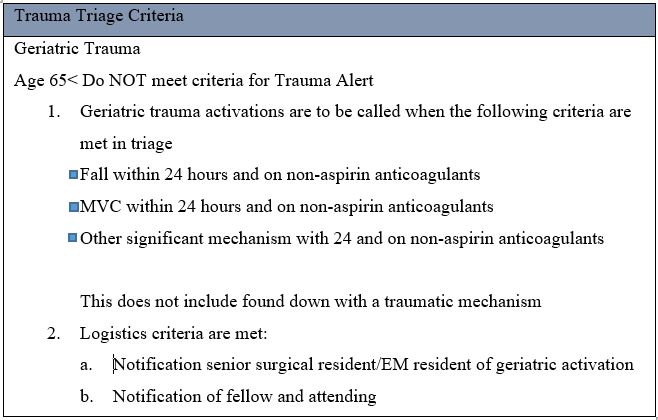The United States is in the midst of significant population aging. The burden of injury among older patients continues to grow. Elderly trauma victims account for 25 percent of all injury fatalities and 35 percent of trauma health care dollars. It has been well demonstrated that Elderly patients can sustain significant harm with minor mechanism. Even those that do not meet criteria for trauma activations harbor serious injury and require immediate high-level care. Age, medical co-morbidities, medications, physiologic reserve may confound their care and is associated with higher mortality and complication rates [1].
Geriatric patients have distinct differences and require additional and more in-depth assessment. These patients present with a myriad of vulnerabilities; delirium, malnutrition, immobility, as well as functional decline of organ systems and protective regulatory responses [2]. Early recognition of injuries and potential complications can significantly impact overall care needs. The American College of Surgeons (ACS) recognizes that guidelines specific to geriatric trauma care are fundamental to providing appropriate intervention and improving outcomes. Processes that support expedited triage and transport to trauma centers considering geriatric risk factors and physiologic responses advance treatment opportunities.
Consideration of all risk factors and vulnerabilities have resulted in recommendations, guidelines and protocols aimed at improving the multi-disciplinary approach to elder trauma care. Employing better risk assessment and injury recognition affords early implementation of standardized criteria and intervention models (ACS). Recognizing opportunity in our own trauma center, a two-tiered trauma triage process was developed and implemented. Tier two; geriatric trauma activation-initiated valuation items specific to risk factors. Utilizing the ACS Geriatric Trauma Management Guidelines, modified triage assessment criteria were identified. Staff education was provided to ensure criteria and assessment were applied correctly. To add efficiencies to the process, Geriatric triage documentation was added to triage assessment tool in an electronic format. This provides ease of documentation, tracking and flow into the trauma registry data base.

Three months (December 1, 2019 through April 1, 2020) of data yield 30 geriatric activations, 10% discharged, 90% admitted, no injury related death. Developing and implementing a tiered triage approach, has resulted in decreased delays in diagnosis and improved results for the patients treated through this process. Staff have a greater appreciation of the perils associated with elderly trauma and the value of expedited treatment. Educational opportunities and the implementation of specific geriatric resources are evolving. Designated provider teams and structured plans for management contribute to positive outcomes. As our aged population continues to grow with the associated risk factors, it is imperative we continue our quest to provide better and more intentional approaches for this populace of trauma patients.
- American College of Surgeons Committee on Trauma. ACS TQIP Geriatric Trauma Management Guidelines, 2018.
- Washington State Department of Health. Trauma Clinical Guideline: Geriatric Trauma Care. December, 2015.
Editorial Information
Editor-in-Chief
Article type
Commentary
Publication History
Received: April 17, 2020
Accepted: April 24, 2020
Published: April 29, 2020
Copyright
©2020 Floyd D. This is an open-access article distributed under the terms of the Creative Commons Attribution License, which permits unrestricted use, distribution, and reproduction in any medium, provided the original author and source are credited.
Citation
Floyd D (2020) Relationship between person with dementia and adolescents: A preliminary survey of the Association Between Children and Dementia Elders (ABCDE) Project. Nurs Palliat Care 5: DOI: 10.15761/NPC.1000213.
Corresponding author
Diane Floyd
Clinical Director of Trauma, Cooper University Health Care, USA
E-mail : bhuvaneswari.bibleraaj@uhsm.nhs.uk
